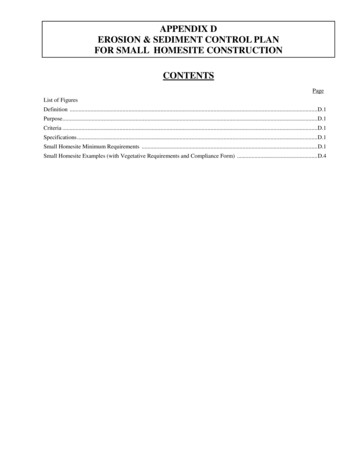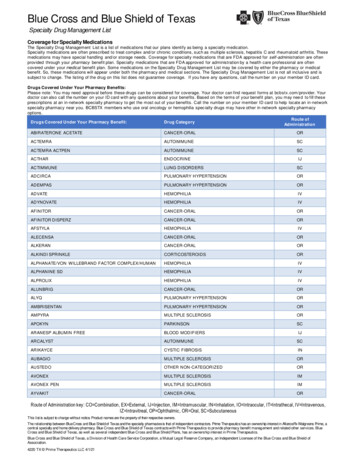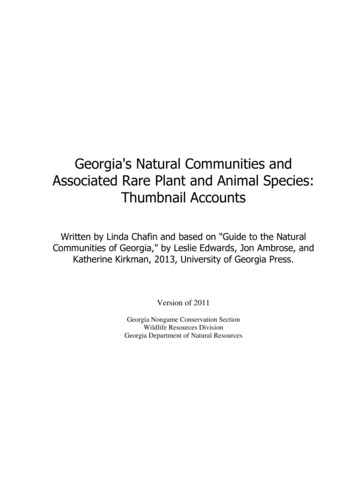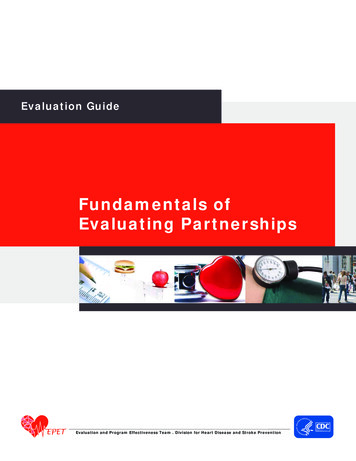
Transcription
APPENDIX DEROSION & SEDIMENT CONTROL PLANFOR SMALL HOMESITE CONSTRUCTIONCONTENTSPageList of FiguresDefinition . D.1Purpose. D.1Criteria . D.1Specifications . D.1Small Homesite Minimum Requirements . D.1Small Homesite Examples (with Vegetative Requirements and Compliance Form) . D.4
Appendix prepared by:Paula Smith, CPESC, CPSWQFormer Stormwater Management SpecialistNew York State Department of EnvironmentalConservation, Region 8 and the NYS DEC GeneralPermits Section Staff , Central Office, Albany
List of FiguresFigureTitlePageD.1D.2D.3D.4D.5D.6Erosion Control Plan Condition 1 . D.3Erosion Control Plan Condition 2 . D.5Erosion Control Plan Condition 3 . D.7Erosion Control Plan Condition 4 . D.9Construction Details for Stabilized Construction Entrance and Silt Fence . D.11Construction Details for Straw Bale Dike and Rock Check Dam . D.12
EROSION AND SEDIMENT CONTROL PLANFOR SMALL HOMESITE CONSTRUCTIONDefinition Small homesite erosion and sediment control plans are agroup of minimum erosion and sediment control practicesand management techniques that apply to small homesiteconstruction activity on a single residential lot, in order toprevent polluted discharge. PurposeThis appendix lays out a series of minimum requirementsfor erosion and sediment control, and management practicesthat may be used to meet these requirements. Use of thesetemplates will help show compliance with the generalrequirements for construction activities that require basicstormwater pollution prevention plans (SWPPP). Thisapplies to the construction of small homesites. The owner/developer must complete the relevant conditions (1-4), orsmall parcel erosion and sediment control plan included inthis section, and submit the NOI in order to meetcompliance with the SPDES General Permit for StormwaterDischarges From Construction Activities.CriteriaGenerally, several types of practices are required on anyone site for effective erosion and sediment control. Thereare three broad categories of construction-related practicesfor controlling erosion and sediment on small homesitedevelopments:1.Cover practices pr event er osion by pr otecting thesoil surface from rainfall and runoff. Prevention oferosion is the most preferable and cost-effectiveapproach. These practices include: protection ofexisting vegetation; temporary covering of exposed soilby mulching, matting, or covering; and permanent sitestabilization by topsoiling, seeding, and/or sodding.2.Structural Practices ar e str uctur al contr ols thateither reduce erosion, control runoff, or keep sedimenton the construction site. Examples of these practicesinclude stabilized construction entrances, silt fences,sediment traps, berms, and check dams.3.Management Measures ar e constr uctionmanagement methods that prevent or reduce erosionpotential and ensure the proper functioning of erosionand sediment control practices. Careful constructionmanagement can dramatically reduce the costsassociated with erosion and sediment problems.Examples of these management measures include: Preserving existing trees and grass where possibleNew York State Standards and SpecificationsFor Erosion and Sediment Control to prevent erosion;Decompacting and re-vegetating the site as soon aspossible;Locating soil piles away from roads or waterways;Limiting tracking of mud onto streets by requiringall vehicles to use designated access drives;Removing sediment carried off-site by vehicles orstorms;Installing downspout extenders to prevent erosionfrom roof runoff; andMaintaining erosion and sediment practicesthrough sediment removal, structure replacement,etc.SpecificationsEach construction site is different. The owner/developer ofa small construction site may choose and follow one of thefour variations of ESC plans included in this section todevelop a SWPPP in compliance with the SPDESConstruction Permit For Stormwater Discharges FromConstruction Activities. However, because of the generalnature of the following conditions, the plans included in thissection may not cover all of the resource protectionneeds on a particular site, and this form does not exemptan owner from the responsibility of filing an NOI, ifrequired.Small Homesite Minimum Requirements:1.Stabilized Construction Entrance:To prevent vehicles and equipment from tracking sedimentand mud off-site, apply gravel or crushed rock to thedriveway area and restrict traffic to this one route. Thispractice will help keep soil from sticking to tires and stopsoil from washing off into the street. Carry out periodicinspections and maintenance including washing, topdressing with additional stone, reworking, and compaction.Plan for periodic street cleaning to remove any sedimentthat may have been tracked off-site. Remove sediment byshoveling or sweeping and transport to a suitable disposalarea where it can be stabilized.2.Stabilization of Denuded Areas:In areas where soil disturbance activity has temporarily orpermanently ceased, the application of soil stabilizationmeasures must be initiated by the end of the next businessday and completed within fourteen (14) days from the datethe current soil disturbance activity ceased. Forconstruction sites that directly discharge to one of the 303(d) segments listed in the Construction General Permit or isPage D.1November 2016
located in one of the watersheds listed in Appendix C, theapplication of soil stabilization measures must be initiatedby the end of the next business day and completed withinseven (7) days from the date the current soil disturbanceactivity ceased.dam—if not maintained, high flows could cause erosionaround the sides of the structures, adding significantsediment loads downstream.Stabilize disturbed areas by implementing soil coveringpractices (e.g. mulching, matting, sodding). Exposed soilsare the most prone to erosion from rainfall and runoff.Vegetation helps protect the soil from these forces andprovides natural erosion control. Plan construction to limitthe amount of exposed area, and avoid grading activitiesduring the rainy season (November through March) asmuch as possible. Clearing limits should be clearly markedand kept as small as possible. Once construction iscompleted, the site must be permanently stabilized withtopsoiling, seeding and plantings, or sodding if needed.Maintain erosion and sediment control practices throughregular inspection. Regular maintenance is extremelyimportant for the proper operation of structural practices.After initial groundbreaking, the responsible contractorshall conduct daily maintenance inspections within theactive work area to ensure practices are being maintained ineffective operating conditions at all times.3.Protection of Adjacent Properties:Keep sediment on-site by using structural and sourcecontrol practices (e.g. vegetative buffer strips, sedimentbarriers, soil berms or dikes, etc). See Sections 3, 4, or 5 asappropriate. Wherever possible, preserve a buffer ofexisting vegetation around the site boundary. This will helpto decrease runoff velocities and trap sediment suspended inthe runoff. Other structural controls such as filter fence orstraw bale barriers should also be used to filter runoff andtrap sediment on-site.When excavating basement soils, move the soil to a locationthat is, or will be, vegetated, such as in the backyard or sideyard area. This will increase the distance eroded soil musttravel, through vegetation, to reach the storm sewer system.Piles should be situated so that sediment does not run intothe street or adjoining yards. Soil piles should betemporarily seeded and circled with silt fence until the soilis either replaced or removed. Backfill basement walls assoon as possible and rough grade the lot. This will eliminatethe large soil mounds, which are highly erodible, andprepare the lot for temporary cover. After backfilling, gradeor remove excess soil from the site quickly, to eliminate anysediment loss from surplus fill.4.5.6.Maintenance:Soil Restoration:Soils that have been disturbed and compacted due toconstruction activities should be de-compacted to restoretheir previous hydrologic condition. This normally involvesaeration of small areas for home sites. Large areas shouldbe restored in accordance with the Soil Restoration standardin Section 4 of this book of standards.7.Other Practices:Use additional practices as required by the local planapproval authority to mitigate effects of increased runoff.This may include providing additional controls to a locallyprotected stream or resource area, protecting ripariancorridors (vegetative stream buffers), etc. Individualhomeowners and/or developers are responsible forresearching additional requirements related to erosion andsediment runoff control established by their localjurisdictions.Concentrated Flow:For constructed drainage ways, or other areas ofconcentrated flow, install check dams according to thespecifications on page E.12 to reduce erosion in thechannel. As with other erosion controls, check dams mustbe inspected regularly. Remove sediment accumulatedbehind the dam as needed to allow channel to drain throughthe stone check dam and prevent large flows from carryingsediment over the dam Replace stones as needed tomaintain the design cross section of the structures.Sediment removal is crucial to the effectiveness of theNovember 2016Page D.2New York State Standards and SpecificationsFor Erosion and Sediment Control
Figure D.1Erosion Control Plan Condition 13. Use additional practices asrequired by local code enforcement or as needed to mitigatewater quality impacts.New York State Standards and SpecificationsFor Erosion and Sediment ControlPage D.3November 2016
Condition 1—Vegetative Requirements & Compliance FormVegetation Requirements:1)Site PreparationA.B.C.D.E.F.Install needed water and erosion control measures and bring area to be seeded to desired grades using a minimum of 4 in. topsoil.Prepare seedbed by loosening soil to a depth of 4-6 inches.Lime to a pH of 6.5Fertilize as per soil test or, if fertilizer must be applied before soil test results are received, apply 850 pounds of 5-10-10 orequivalent per acre (20 lbs/1,000 sq. ft.)Incorporate lime and fertilizer in top 2-4 inches of topsoil.Smooth. Remove all stones over 1 inch in diameter, sticks, and foreign matter from the surface. Firm the seedbed.2)Planting—Sunny Location.Upon completing soil de-compaction, use a cultipacker type seeder if possible. Seed to a depth of 1/8 to 1/4 inch. If seed is to bebroadcast, cultipack or roll after seeding. If hydroseeded, lime and fertilizer may be applied through the seeder and rolling is not practical.Seed using the following mix and rates:Species (% by weight)lbs/1,000sq. ft65% Kentucky bluegrass blend . . 2.0-2.6 .20% perennial ryegrass . 0.6-0.8 .15% fine fescue . 0.4-0.6 .Total . 3.0-4.0 .or,100% Tall fescue, Turf-type, fine leaf . 3.4-4.6 .3)lbs./acre85-11426-3519-26130-175150-200When using the cultipacker or broadcast seed method, mulch using small grain straw, applied at a rate of 2 tons per acre; and anchorwith a netting or tackifier. Hydroseed applications should include mulch, fertilizer and seed.Common white clover can be added to mixtures at the rate of 1-2 lbs/acre to help maintain green color during the dry summerperiod, however, they will not withstand heavy traffic. Fertilizing—First year, (spring seedlings) three to four weeks aftergermination apply 1 pound nitrogen/1,000 square feet using a complete fertilizer with a 2-1-1 or 4-1-3 ratio or as recommended bysoil test results. For summer and early fall seedings, apply as above unless air temperatures are above 85ºF for extended period. Waituntil heat wave is over to fertilize. For late fall/ winter seedings, fertilize in spring. Restrict use—new seedlings should be protectedfrom use for one full year to allow development of a dense sod with good root structure.Certification StatementPlease complete and sign this 2-sided document (with Typical Erosion Control Plan) and attach to BLUEPRINTS and SITEPLAN prior to any earth disturbance. These documents must be kept on site and be available for review as requested by anyagent of the NYSDEC. This 2-sided form can be used as a basic stormwater pollution prevention plan, but will notexempt a landowner from filing a Notice of Intent.“I hereby certify under penalty of law that I understand and agree to comply with the terms and conditions of the SWPPP and agree toimplement any corrective actions identified by the qualified inspectors during a site inspection. I also understand that the owner or operatormust comply with the term and conditions of the most current version of the New York State Pollutant Discharge Elimination System(SPDES) general permit for stormwater discharges from construction activities and that is unlawful for any person to cause of contribute toa violation of water quality standards. Furthermore, I am aware that there are significant penalties for submitting false information, that I donot believe to be true, including the possibility of fine and imprisonment for know violations.”Builder/Contractor (print)SignatureAddressNovember 2016Page D.4New York State Standards and SpecificationsFor Erosion and Sediment Control
Figure D.2Erosion Control Plan Condition 2New York State Standards and SpecificationsFor Erosion and Sediment ControlPage D.5November 2016
Condition 2—Vegetative Requirements & Compliance FormVegetation Requirements:1)Site PreparationA.B.C.D.E.F.Install needed water and erosion control measures and bring area to be seeded to desired grades using a minimum of 4 in. topsoil.Prepare seedbed by loosening soil to a depth of 4-6 inches.Lime to a pH of 6.5Fertilize as per soil test or, if fertilizer must be applied before soil test results are received, apply 850 pounds of 5-10-10 orequivalent per acre (20 lbs/1,000 sq. ft.)Incorporate lime and fertilizer in top 2-4 inches of topsoil.Smooth. Remove all stones over 1 inch in diameter, sticks, and foreign matter from the surface. Firm the seedbed.2)Planting—Sunny Location.Upon completing soil de-compaction, use a cultipacker type seeder if possible. Seed to a depth of 1/8 to 1/4 inch. If seed is to bebroadcast, cultipack or roll after seeding. If hydroseeded, lime and fertilizer may be applied through the seeder and rolling is not practical.Seed using the following mix and rates:Species (% by weight)lbs/1,000sq. ft65% Kentucky bluegrass blend . . 2.0-2.6 .20% perennial ryegrass . 0.6-0.8 .15% fine fescue . 0.4-0.6 .Total . 3.0-4.0 .or,100% Tall fescue, Turf-type, fine leaf . 3.4-4.6 .3)lbs./acre85-11426-3519-26130-175150-200When using the cultipacker or broadcast seed method, mulch using small grain straw, applied at a rate of 2 tons per acre; and anchorwith a netting or tackifier. Hydroseed applications should include mulch, fertilizer and seed.Common white clover can be added to mixtures at the rate of 1-2 lbs/acre to help maintain green color during the dry summerperiod, however, they will not withstand heavy traffic. Fertilizing—First year, (spring seedlings) three to four weeks aftergermination apply 1 pound nitrogen/1,000 square feet using a complete fertilizer with a 2-1-1 or 4-1-3 ratio or as recommended bysoil test results. For summer and early fall seedings, apply as above unless air temperatures are above 85ºF for extended period. Waituntil heat wave is over to fertilize. For late fall/ winter seedings, fertilize in spring. Restrict use—new seedlings should be protectedfrom use for one full year to allow development of a dense sod with good root structure.Certification StatementPlease complete and sign this 2-sided document (with Typical Erosion Control Plan) and attach to BLUEPRINTS and SITEPLAN prior to any earth disturbance. These documents must be kept on site and be available for review as requested by anyagent of the NYSDEC. This 2-sided form can be used as a basic stormwater pollution prevention plan, but will notexempt a landowner from filing a Notice of Intent.“I hereby certify under penalty of law that I understand and agree to comply with the terms and conditions of the SWPPP and agree toimplement any corrective actions identified by the qualified inspectors during a site inspection. I also understand that the owner or operatormust comply with the term and conditions of the most current version of the New York State Pollutant Discharge Elimination System(SPDES) general permit for stormwater discharges from construction activities and that is unlawful for any person to cause of contribute toa violation of water quality standards. Furthermore, I am aware that there are significant penalties for submitting false information, that I donot believe to be true, including the possibility of fine and imprisonment for know violations.”Builder/Contractor (print)SignatureAddressNovember 2016Page D.6New York State Standards and SpecificationsFor Erosion and Sediment Control
Figure D.3Erosion Control Plan Condition 3New York State Standards and SpecificationsFor Erosion and Sediment ControlPage D.7November 2016
Condition 3—Vegetative Requirements & Compliance FormVegetation Requirements:1)Site PreparationA.B.C.D.E.F.Install needed water and erosion control measures and bring area to be seeded to desired grades using a minimum of 4 in. topsoil.Prepare seedbed by loosening soil to a depth of 4-6 inches.Lime to a pH of 6.5Fertilize as per soil test or, if fertilizer must be applied before soil test results are received, apply 850 pounds of 5-10-10 orequivalent per acre (20 lbs/1,000 sq. ft.)Incorporate lime and fertilizer in top 2-4 inches of topsoil.Smooth. Remove all stones over 1 inch in diameter, sticks, and foreign matter from the surface. Firm the seedbed.2)Planting—Sunny Location.Upon completing soil de-compaction, use a cultipacker type seeder if possible. Seed to a depth of 1/8 to 1/4 inch. If seed is to bebroadcast, cultipack or roll after seeding. If hydroseeded, lime and fertilizer may be applied through the seeder and rolling is not practical.Seed using the following mix and rates:Species (% by weight)lbs/1,000sq. ft65% Kentucky bluegrass blend . . 2.0-2.6 .20% perennial ryegrass . 0.6-0.8 .15% fine fescue . 0.4-0.6 .Total . 3.0-4.0 .or,100% Tall fescue, Turf-type, fine leaf . 3.4-4.6 .3)lbs./acre85-11426-3519-26130-175150-200When using the cultipacker or broadcast seed method, mulch using small grain straw, applied at a rate of 2 tons per acre; and anchorwith a netting or tackifier. Hydroseed applications should include mulch, fertilizer and seed.Common white clover can be added to mixtures at the rate of 1-2 lbs/acre to help maintain green color during the dry summerperiod, however, they will not withstand heavy traffic. Fertilizing—First year, (spring seedlings) three to four weeks aftergermination apply 1 pound nitrogen/1,000 square feet using a complete fertilizer with a 2-1-1 or 4-1-3 ratio or as recommended bysoil test results. For summer and early fall seedings, apply as above unless air temperatures are above 85ºF for extended period. Waituntil heat wave is over to fertilize. For late fall/ winter seedings, fertilize in spring. Restrict use—new seedlings should be protectedfrom use for one full year to allow development of a dense sod with good root structure.Certification StatementPlease complete and sign this 2-sided document (with Typical Erosion Control Plan) and attach to BLUEPRINTS and SITEPLAN prior to any earth disturbance. These documents must be kept on site and be available for review as requested by anyagent of the NYSDEC. This 2-sided form can be used as a basic stormwater pollution prevention plan, but will notexempt a landowner from filing a Notice of Intent.“I hereby certify under penalty of law that I understand and agree to comply with the terms and conditions of the SWPPP and agree toimplement any corrective actions identified by the qualified inspectors during a site inspection. I also understand that the owner or operatormust comply with the term and conditions of the most current version of the New York State Pollutant Discharge Elimination System(SPDES) general permit for stormwater discharges from construction activities and that is unlawful for any person to cause of contribute toa violation of water quality standards. Furthermore, I am aware that there are significant penalties for submitting false information, that I donot believe to be true, including the possibility of fine and imprisonment for know violations.”Builder/Contractor (print)SignatureAddressNovember 2016Page D.8New York State Standards and SpecificationsFor Erosion and Sediment Control
Figure D.4Erosion Control Plan Condition 4New York State Standards and SpecificationsFor Erosion and Sediment ControlPage D.9November 2016
Condition 4—Vegetative Requirements & Compliance FormVegetation Requirements:1)Site PreparationA.B.C.D.E.F.Install needed water and erosion control measures and bring area to be seeded to desired grades using a minimum of 4 in. topsoil.Prepare seedbed by loosening soil to a depth of 4-6 inches.Lime to a pH of 6.5Fertilize as per soil test or, if fertilizer must be applied before soil test results are received, apply 850 pounds of 5-10-10 orequivalent per acre (20 lbs/1,000 sq. ft.)Incorporate lime and fertilizer in top 2-4 inches of topsoil.Smooth. Remove all stones over 1 inch in diameter, sticks, and foreign matter from the surface. Firm the seedbed.2)Planting—Sunny Location.Upon completing soil de-compaction, use a cultipacker type seeder if possible. Seed to a depth of 1/8 to 1/4 inch. If seed is to bebroadcast, cultipack or roll after seeding. If hydroseeded, lime and fertilizer may be applied through the seeder and rolling is not practical.Seed using the following mix and rates:Species (% by weight)lbs/1,000sq. ft65% Kentucky bluegrass blend . . 2.0-2.6 .20% perennial ryegrass . 0.6-0.8 .15% fine fescue . 0.4-0.6 .Total . 3.0-4.0 .or,100% Tall fescue, Turf-type, fine leaf . 3.4-4.6 .3)lbs./acre85-11426-3519-26130-175150-200When using the cultipacker or broadcast seed method, mulch using small grain straw, applied at a rate of 2 tons per acre; and anchorwith a netting or tackifier. Hydroseed applications should include mulch, fertilizer and seed.Common white clover can be added to mixtures at the rate of 1-2 lbs/acre to help maintain green color during the dry summerperiod, however, they will not withstand heavy traffic. Fertilizing—First year, (spring seedlings) three to four weeks aftergermination apply 1 pound nitrogen/1,000 square feet using a complete fertilizer with a 2-1-1 or 4-1-3 ratio or as recommended bysoil test results. For summer and early fall seedings, apply as above unless air temperatures are above 85ºF for extended period. Waituntil heat wave is over to fertilize. For late fall/ winter seedings, fertilize in spring. Restrict use—new seedlings should be protectedfrom use for one full year to allow development of a dense sod with good root structure.Certification StatementPlease complete and sign this 2-sided document (with Typical Erosion Control Plan) and attach to BLUEPRINTS and SITEPLAN prior to any earth disturbance. These documents must be kept on site and be available for review as requested by anyagent of the NYSDEC. This 2-sided form can be used as a basic stormwater pollution prevention plan, but will notexempt a landowner from filing a Notice of Intent.“I hereby certify under penalty of law that I understand and agree to comply with the terms and conditions of the SWPPP and agree toimplement any corrective actions identified by the qualified inspectors during a site inspection. I also understand that the owner or operatormust comply with the term and conditions of the most current version of the New York State Pollutant Discharge Elimination System(SPDES) general permit for stormwater discharges from construction activities and that is unlawful for any person to cause of contribute toa violation of water quality standards. Furthermore, I am aware that there are significant penalties for submitting false information, that I donot believe to be true, including the possibility of fine and imprisonment for know violations.”Builder/Contractor (print)SignatureAddressNovember 2016Page D.10New York State Standards and SpecificationsFor Erosion and Sediment Control
Figure D.5Construction Details for Stabilized Construction Entrance and SiltNew York State Standards and SpecificationsFor Erosion and Sediment ControlPage D.11November 2016
Figure D.6Construction Details for Straw Bale Dike and Check DamNovember 2016Page D.12New York State Standards and SpecificationsFor Erosion and Sediment Control
include stabilized construction entrances, silt fences, sediment traps, berms, and check dams. 3. Management Measures are construction management methods that prevent or reduce erosion potential and ensure the proper functioning of erosion and sediment control practices. Careful construction management can dramatically reduce the costs











